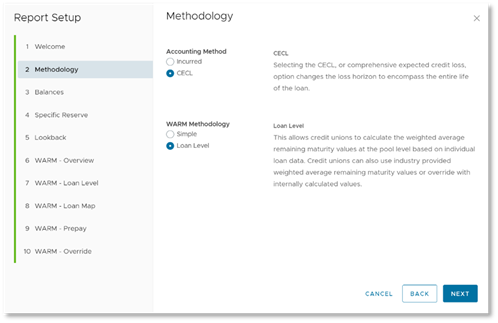High Level Release Notes
- TDR & Impaired screen has changed to Specific Reserves, to adjust for FASB changes to TDR Requirements. Read more below....
- A new feature to calculate weighted average remaining maturity values for each loan pool based off your loan-level information, creating a CECL reserve precise to your credit union. Read more below...
- Verbiage improvements throughout the application, based off user feedback, to promote better understanding and use of the product.
- CU Clarity will be undergoing a name change to Accolade Analytics to better represent the future vision of the product. You will see this name change happening slowly, but this will not impact how you use the tool.
Specific Reserves

To adjust for the changes to TDR requirements, step four has changed to Specific Reserves. Just enter the total amount of specific reserves for all loans with specific reserves in the "Expected Loss Amount" input section.
Then use the specific reserve column to add the total principle balance of all loans with specific reserves for each loan pool. This will ensure that you are no longer calculating a CECL reserve for loans that already have specific reserves.
Weighted Average Remaining Maturity Calculator
The WARM methodology is one of the simplest CECL methodologies available to credit unions, but it is still difficult to execute on your own. Calculating the weighted average remaining maturity of your loan portfolios can be complicated, so this new feature helps you calculate a WARM value specific to your credit union’s portfolio (with a little data input from you).
Credit unions can now decide to either:
- Use a Simple methodology and select WARM assumptions based on either our industry average calculations or provide their own estimates.
- Calculate the weighted average remaining maturity values at the pool level based on individual loan data. Credit unions can also use industry provided weighted average remaining maturity values or override with internally calculated values.
To calculate WARM values specific to your credit union:
1. On Step 2, the Methodology screen, select the CECL Accounting Method and then the Loan Level WARM Methodology option:

- Download the loan template and add your loan information to the template.
- Upload your data and review the balances.

- Upload your DEXA mapping and check the balances for your mapped loans.

- Review the Adj Paydown value and adjust Annual Prepay Rate to match the Est. Total Paydown to what payments your credit union typically gets for each loan pool.

- Review the industry average and calculated weighted average reaming maturity values and adjust as needed with your own overrides.

Just like that, in 6 easy steps you can calculate the WARM value for loan pools specific to your credit unions portfolio. We are committed to continuing to enhance our CECL solutions and are excited to bring these new features to you.
Have any questions or feedback about these new features? Contact us today